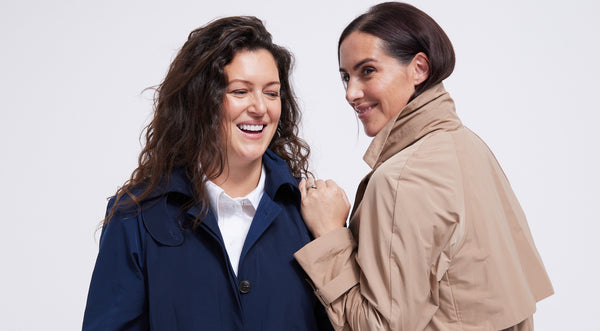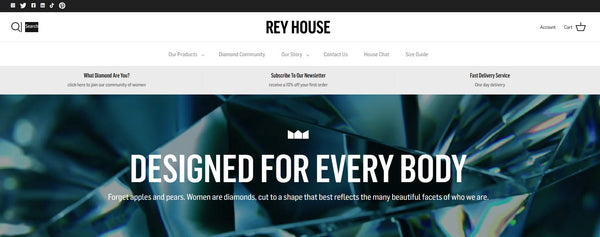
Ethnicity and Body Shape
As we age, our bodies undergo many changes. From hormonal shifts to changes in metabolism, our bodies can look very different at 35 than they did at 25. But does ethnicity play a role in how our bodies change over time? Specifically, does ethnicity tend to define body shape for women aged 35 and up in the UK?
The question has been a topic of interest for many years. While there are certainly some differences in body shape among different ethnic groups, a range of factors can impact body shape and wellbeing in women, regardless of their ethnicity.
It's important to note that changes in body shape are a natural part of the ageing process. As women enter their mid-30s and beyond, they may experience a range of physical changes, including changes in body shape. For example, women may experience a shift in fat distribution from their hips and thighs to their midsection, leading to an increase in waist circumference. Hormonal changes can also impact body shape, with women experiencing a decline in oestrogen levels as they enter perimenopause and menopause. This decline in oestrogen can lead to changes in fat distribution and muscle mass, which can impact body shape.
So to answer this question, we'll take a look at statistical data from the past four decades as well as some case studies of women from different ethnic backgrounds in the UK. By the end of this post, you'll have a better understanding of how ethnicity can impact body shape in women aged 35 and up in the UK.
Defining Body Shape
Before we dive into the data, let's take a moment to define body shape. Body shape is determined by a number of factors, including genetics, hormones, and lifestyle.
While there are many different body shape classifications out there, we'll be focusing on the 7 main categories that we at Rey House have identified:
-
Brilliant Cut Diamond:
Carry weight around their midsection, with a larger bust and good hip area. Fuller arms and legs too. -
Heart Cut Diamond:
Similar to Brilliant Cut, but smaller hips and legs. -
Trillion Cut Diamond:
Can carry weight in their hips, thighs, and buttocks, with a smaller bust and a narrower waist area. -
Double Trillion Cut:
Women with an hourglass-shaped body have a balanced hip and bust measurement with a smaller waist. -
Emerald Cut Diamond:
A square shape, strong shoulders and bust, waist, hip ratio pretty straight. -
Marquis Cut Diamond:
Straight up and down no accentuating assets. These women tend to be tall and lean. -
Classic Cut Diamond:
The most under talked about of all the shapes. Slim shoulders, arms and legs, modest hips, but fuller bust and tummy.

These body shape classifications are important to keep in mind as we explore the impact of ethnicity on body shape in women 35 and up in the UK.
Statistical Data
Let's start by taking a look at some statistical data from the past four decades in the UK. In the 1980s, the average weight for women in the UK was around 9 stone. By the 2000s, that number had risen to 11 stone. Today, the average weight for women in the UK is around 11.5 stone. We don’t actually like using the terms apple shaped and pear shaped, we don’t want to think of women as a piece of fruit! However, for the sake of the research that has been carried out around the world it may be easier to use these references. We do not believe them to be detailed enough in their description.
While this increase in weight is not specific to any one ethnicity, it does impact body shape. Women who carry more weight tend to have an apple or pear-shaped body, regardless of ethnicity. This means that as weight has increased over time, so too has the prevalence of apple and pear-shaped bodies.
When it comes to ethnicity, there are some notable differences in body shape in the UK. According to a study published in the Journal of Public Health, South Asian women in the UK tend to have a higher waist circumference and a greater prevalence of central obesity (i.e. an apple-shaped body) compared to white women. This study was conducted among women aged 40-69, but it's possible that these differences in body shape could be present in younger women as well.
Another study published in the International Journal of Obesity found that Black Caribbean women in the UK tend to have a higher BMI than white women. However, the study also found that Black Caribbean women have a lower prevalence of central obesity compared to white women, meaning they are less likely to have an apple-shaped body.
These statistics suggest that ethnicity can play a role in body shape, with South Asian women tending to have a higher prevalence of apple-shaped bodies compared to white women in the UK. However, Black Caribbean women tend to have a higher BMI but are less likely to have an apple-shaped body compared to white women in the UK.
Case Studies
While statistical data can provide us with a broad understanding of body shape and ethnicity, it's important to also look at individual case studies. Let's take a look at a few examples of women from different ethnic backgrounds in the UK to see how their body shape has changed over time.
Case Study 1 - Woman age 35, Indian origin
A 35-year-old Indian woman living in the UK. She has noticed that her body shape has changed over time, and she's not alone. According to a study published in the Journal of Public Health, South Asian women in the UK tend to have a higher waist circumference and a greater prevalence of central obesity compared to white women.
Her body shape has shifted from an hourglass shape in her 20s to an apple shape in her 30s. She attributes this shift to a number of factors, including changes in her diet and a more sedentary lifestyle. She used to be very active in her younger years, but as she's gotten older, she's found it harder to make time for exercise.
To combat her changing body shape, She has started to focus on eating a healthier diet and incorporating more exercise into her daily routine. She's also considering working with a personal trainer to help her develop a workout plan that is tailored to her specific needs.
Case Study 2 - Woman age 40, White British
A 40-year-old White British woman living in the UK. She has always had a pear-shaped body, with wider hips and a smaller bust. As she's gotten older, She has noticed that her body shape has shifted slightly. While she still has a pear-shaped body, she's noticed that her midsection has become a bit wider.
She attributes this shift to hormonal changes that come with age. She's also noticed that she's not as active as she used to be, which could be contributing to her changing body shape. To combat this, she has started to focus on eating a healthier diet and incorporating more exercise into her daily routine. She's also considering working with a personal trainer to help her develop a workout plan that is tailored to her specific needs.
Case Study 3 - Woman age 38, Black Caribbean origin
A 38-year-old Black Caribbean woman living in the UK. She has always had a curvy hourglass-shaped body, with a balanced hip and bust measurement and a smaller waist. As she's gotten older, She has noticed that her body shape has remained relatively consistent, although she has noticed a slight increase in her waist circumference.
She attributes this shift to a combination of factors, including hormonal changes and changes in her diet and exercise habits. While she still maintains a healthy diet and stays active, She has noticed that it's harder to maintain her body shape as she's gotten older.
To combat this, She has started to focus on incorporating more strength training into her exercise routine. She's also working with a nutritionist to develop a meal plan that is tailored to her specific needs. She recognizes that her body shape may continue to shift as she gets older, but she's committed to maintaining a healthy lifestyle to the best of her ability.
Conclusion
In conclusion, ethnicity can play a role in determining body shape, but it is not the only factor. A combination of genetics, lifestyle, and environment can all contribute to the way a woman's body looks and feels.
As women age, they may also experience changes in body shape due to hormonal changes and a decrease in muscle mass. However, maintaining a healthy lifestyle through a balanced diet and regular exercise can help to maintain muscle mass and prevent excessive weight gain. We at Rey House, believe that it is more about what food we eat, how much of it and changes in hormones that attributes to body shape more than activity and also ones natural body shape plays a major part which is genetic.
It's important to note that body shape can also have a significant impact on mental health and wellbeing. Women who are dissatisfied with their body shape may experience lower self-esteem and engage in unhealthy weight loss behaviours, which can have negative impacts on their mental health.
According to a survey by the Mental Health Foundation, 20% of adults in the UK have felt shame or embarrassment about their body image in the last year. Additionally, a report by the Women's Health Taskforce found that eating disorders affect 1.25 million people in the UK, with the majority of sufferers being women.
It is clear that body shape and mental health are closely linked, and it is important to address negative thought patterns and develop a positive body image. Seeking professional help and support from loved ones can be beneficial for improving mental health and developing a healthy relationship with one's body.
In addition to the physical and mental health benefits of maintaining a healthy body shape, there are also social benefits. Women who feel confident and comfortable in their bodies are more likely to engage in social activities and form positive relationships with others.
It is important for society as a whole to recognize the impact of body shape on women's health and wellbeing, and to promote body positivity and acceptance. This can be achieved through education and awareness campaigns, as well as through representation in the media and advertising.
While ethnicity can play a role in determining body shape, it is just one of many factors that contribute to a woman's physical appearance. Maintaining a healthy body shape through a balanced diet, avoiding processed foods and cutting back on sugar can have a positive impact on both physical and mental health, and can also promote social wellbeing. It is important for individuals and society as a whole to recognize the importance of body positivity and acceptance, and to promote healthy lifestyles and positive body image.





